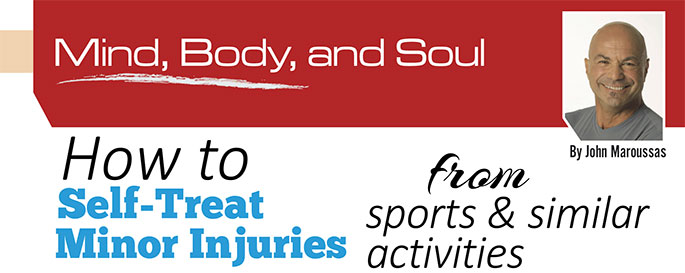Sometimes people get injured and, perhaps because they know it is not serious, they put up  with pain rather than treating the injury. Maybe this is to avoid the expense of a doctor, chiropractor or physical therapist. Well, as long as you base your treatment on good information, there is quite a lot that you can do for yourself. Remember that treatment of injuries must be done at the right time — don’t use a technique that is for immediate relief after an injury if the problem is already several days old: by then you need to switch to something that’s going to work with the healing process.
with pain rather than treating the injury. Maybe this is to avoid the expense of a doctor, chiropractor or physical therapist. Well, as long as you base your treatment on good information, there is quite a lot that you can do for yourself. Remember that treatment of injuries must be done at the right time — don’t use a technique that is for immediate relief after an injury if the problem is already several days old: by then you need to switch to something that’s going to work with the healing process.
 CRYOTHERAPY
CRYOTHERAPY
The application of cold — whether it be ice or a cold patch — can be applied immediately after an acute injury, such as a sprain. Usually 10-15 minutes is long enough. The cold numbs the tissue, reducing pain and reduces swelling by restricting the flow of blood to the area. This is a cheap and effective method, but it is not suitable for long term use.
HEAT THERAPY
Heat is a good treatment once the immediate swelling has abated. Heat draws more blood (and therefore the white blood cells which repair the tissue) into the area of the injury. Again, treatment should be for no more than 10-15 minutes at a time. Keeping a heated pad on an injury for hours can cause static edema — a pooling of blood around the injury — which does no healing because no new white cells will be drawn into the static pool. For more severe injuries, follow the heat treatment with active stretching of the affected body part and, if pain persists, more cold treatment. The ideal method is a hot shower, with the temperature gradually reduced to warm, then stretching, followed by a quick cold shower. A hot to warm shower in the morning and before a workout will relax the tissues and prevent further injury.
CRYO-KINETICS
This is a fancy name for combining cold treatment with specific movements. For lower back and leg recuperation, immediately after showering, lie down on the floor on your back with your legs supported on a bed or sofa. Place an ice pack under your lower back, preferably with crushed ice for more comfort. Now stretch your spine while on the ice and slowly twist your torso alternately from side to side. The motion will prevent your back from stiffening from the effect of the cold pack. This technique is good for relaxing overly tight muscles, and helps to clear any toxins from the area. Once again, the treatment should last no more than 15 minutes.
LEG ELEVATION
After a long day of standing or training, fluids can accumulate in the lower half of your body — in extreme cases this is called lymphedema. In mild cases, leg elevation is a simple and effective way of helping the body regain its fluid balance. Just lie on your back with your lower legs supported by pillows, as high as is comfortable, for about 15 minutes. If knee pain is experienced, combine this with cryotherapy on the knees.
extreme cases this is called lymphedema. In mild cases, leg elevation is a simple and effective way of helping the body regain its fluid balance. Just lie on your back with your lower legs supported by pillows, as high as is comfortable, for about 15 minutes. If knee pain is experienced, combine this with cryotherapy on the knees.
If these treatments do not produce immediate relief, consult a specialist. In most cases however pain and/or swelling will be reduced and the healing process will be speeded up.
Remember that for any acute injury, the immediate treatment is Rest/Ice/Compression/Elevation (R.I.C.E.).















